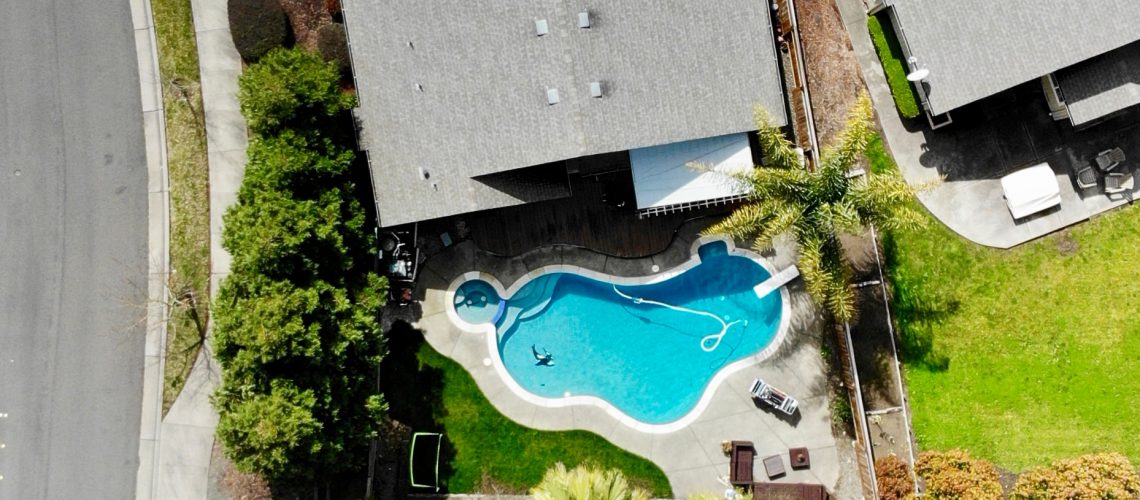Protect your home from termites! Termite management through inspections and active system installations is an important responsibility for homeowners and building managers in South-East Queensland because of the favourable climate for native economically damaging species of Termites such as Coptotermes acinaciformis and Schedorhinotermes intermedius. According to CSIRO FFP Technical Report No. 137 in Brisbane there is a termite incidence rate of 44.7% externally and a termite incident rate of 23.6% internally over the lifetime of properties.
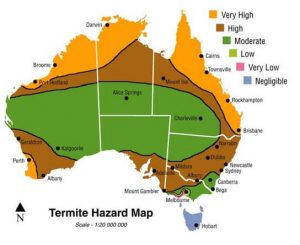
Annual termite inspection
In order to protect your home from termites, termite inspections should be conducted in accordance with AS3660.2-2017 and you should get one every year, potentially more regularly depending on your home’s construction type and the environment it stands in. Many people get an inspection before moving into the house, told that everything was fine and then never have one again, in that time termites move into dark, undisturbed corners of your house, behind shelves in the garage, at the back of cupboards and under sinks and cause a fortune in damage that usually will not be covered by your home insurance.
Queensland houses follow a few construction methods based on age of the 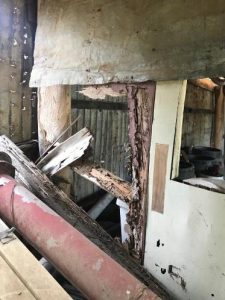 building and its location. Generally, what we see is the older ‘Queenslander’ style houses which are raised up on stumps or stanchions with a subfloor, and concrete foundations wither on the ground or with a in-filled subfloor with a brick surround. Building standards have come a long way over the years, newer houses are built with state-of-the art physical termite barriers which, while not killing or stopping infestations, make it very hard for the termites to enter the timber parts of your house undetected.
building and its location. Generally, what we see is the older ‘Queenslander’ style houses which are raised up on stumps or stanchions with a subfloor, and concrete foundations wither on the ground or with a in-filled subfloor with a brick surround. Building standards have come a long way over the years, newer houses are built with state-of-the art physical termite barriers which, while not killing or stopping infestations, make it very hard for the termites to enter the timber parts of your house undetected.
Slab on ground houses are the pre-eminent building construction for new homes in Queensland and have been for almost thirty years. The foundation is a concrete slab with the house built on top, with a 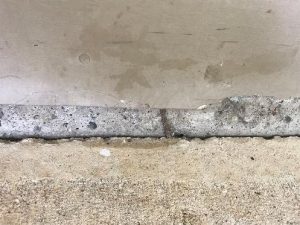 timber frame. As a Termite inspector, these types of houses can pose potential issues of being able to locate a termite infestation underneath the ground. Termites will readily tunnel through the mortar of bricks and the slightest crack in the foundation, as well as the service penetrations through the slab for plumbing and electricity. For homeowners with slab-on-ground houses, we would recommend that the concrete foundation be visible at all times, with garden beds and bushes removed, and the grass trimmed low. This will allow you as a homeowner to be on the lookout for any unusual mud stuck to the outside of the slab and regularly check underneath sinks and in cupboards, for leaks and any unusual activity. As always, at least an annual termite inspection is a must.
timber frame. As a Termite inspector, these types of houses can pose potential issues of being able to locate a termite infestation underneath the ground. Termites will readily tunnel through the mortar of bricks and the slightest crack in the foundation, as well as the service penetrations through the slab for plumbing and electricity. For homeowners with slab-on-ground houses, we would recommend that the concrete foundation be visible at all times, with garden beds and bushes removed, and the grass trimmed low. This will allow you as a homeowner to be on the lookout for any unusual mud stuck to the outside of the slab and regularly check underneath sinks and in cupboards, for leaks and any unusual activity. As always, at least an annual termite inspection is a must.
Homes with an ‘in-fill’ slab type construction pose a serious risk of undetected termite entry and extra vigilance should be taken by homeowners. Generally, the termite entry point will be in between the concrete slab and the brick outer wall and as such, cannot easily be seen from the exterior of the house. Before you know it the termites have eaten into skirting boards, internal walls and the house frame. Make it a routine to pull out stored items from cupboards regularly and check areas you rarely see in your day-to-day life. A termite inspection will help highlight any high-risk areas you may have in your home that require regular checking.
Houses built on stumps were very popular for all building types until very recently and as such, there a large majority of homes in Queensland are of this construction. Stumps range from concrete, timber or steel and in the case of steel stumps, can potentially give a false sense of security for homeowners. Termites will build long tubes from clayey mud to protect their soft bodies from the elements and predators, they are efficient builders and will build these tubes up any surface, linking their subterranean nest to the timber of the house – their feeding ground. Most houses built this way will incorporate a metal ‘ant cap’ or termite shield which works the same way as modern termite physical barrier, as it makes the termite entry point obvious to regular inspection, and if we can see the termites, we can kill them. Problems with this construction type we regularly face when inspecting for termites are when, a few years down the line after the house was originally built, the homeowner builds in downstairs, constructing wood and gyprock walls over the termite shields, negating the visual inspection zone.
Maintain your Garden
Termites are the recyclers of the forest floor, if your garden is unkempt 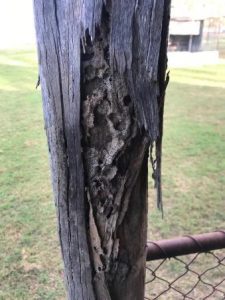 and overgrown, with lots of bushes, trees, old stumps and fallen deadwood, this creates a similar home for them, meaning their population will grow as more food is available. Keeping your garden neat and tidy, with tall trees away from your house will reduce the risk of termites attempting to enter your home.
and overgrown, with lots of bushes, trees, old stumps and fallen deadwood, this creates a similar home for them, meaning their population will grow as more food is available. Keeping your garden neat and tidy, with tall trees away from your house will reduce the risk of termites attempting to enter your home.
Ensure Adequate Drainage
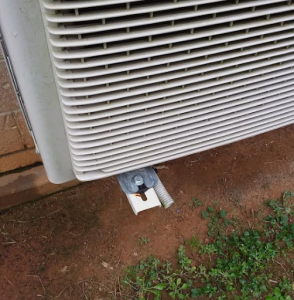 Another attractant is leaks and inadequate drainage, this might be from appliances such as air conditioning units, showers, etc the moisture from leaks may cause damp environments attracting termites, especially to rotting timber. Ensure all leaks are fixed by a qualified plumber and air conditioning units drain away from the house – ideally into an external drain. Air Conditioning Unit draining onto the ground near to the external wall.
Another attractant is leaks and inadequate drainage, this might be from appliances such as air conditioning units, showers, etc the moisture from leaks may cause damp environments attracting termites, especially to rotting timber. Ensure all leaks are fixed by a qualified plumber and air conditioning units drain away from the house – ideally into an external drain. Air Conditioning Unit draining onto the ground near to the external wall.
Ensure Adequate Ventilation
Closed in sub floors without adequate ventilation create the perfect conditions for termite activity. Sub floors with little to no ventilation creates the hot and humid climates termites thrive in. Inadequate ventilation might be caused by too few ventilation vents, inefficient vent placement or blocked vents.
Remove Stored Timber
Storing timber in the garden, sub floor or anywhere around the perimeter of your poses the risk of termite activity. Termites are detritivores, consuming dead plants at any level of decomposition. They consume cellulose, using a specialised midgut that breaks down the fibre. Therefore, having any stored timber around the home is catering to the conditions termites require to thrive.
Check your termite barrier sticker (located inside meter cupboard)
Check your termite barrier sticker, its usually located inside your meter box. The sticker should contain details of the barrier installed, the company who installed it when it was installed and the inspection requirements.
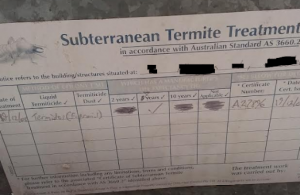
Contact us to find out what the information on your sticker means and help you protect your home from termites! Alternatively, if you don’t have a sticker make sure to book an inspection today to protect your home from termites. We specialise in pest control Brisbane – suburbs!

